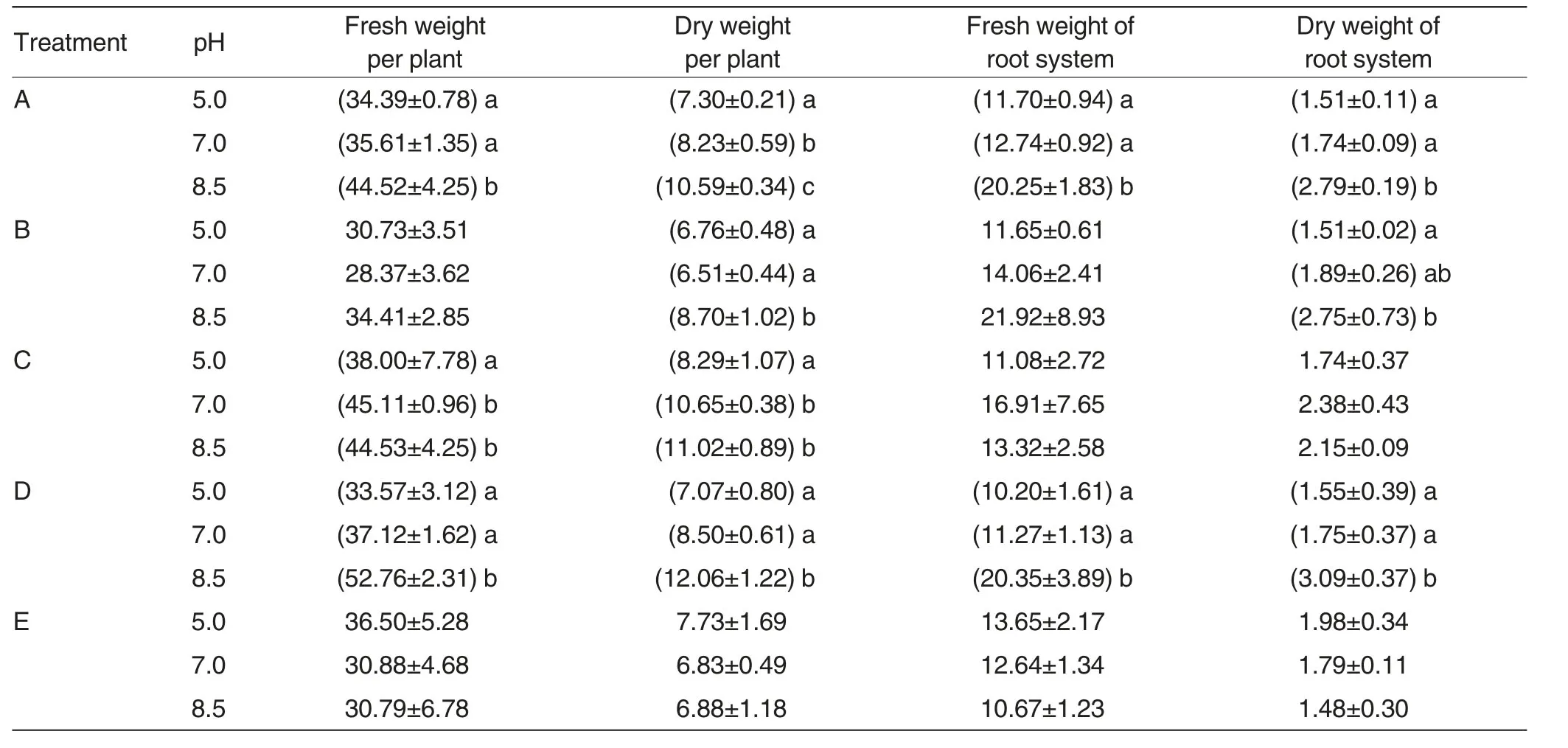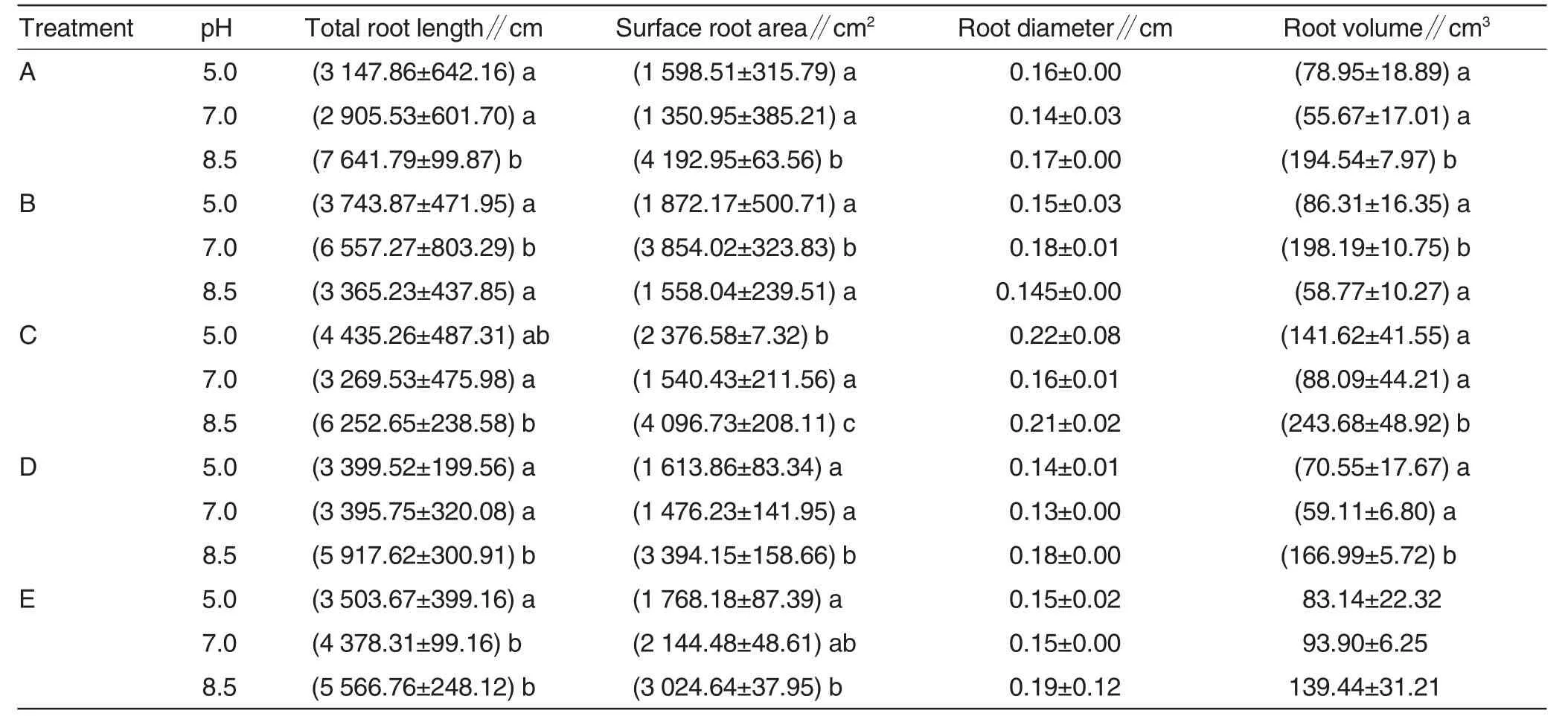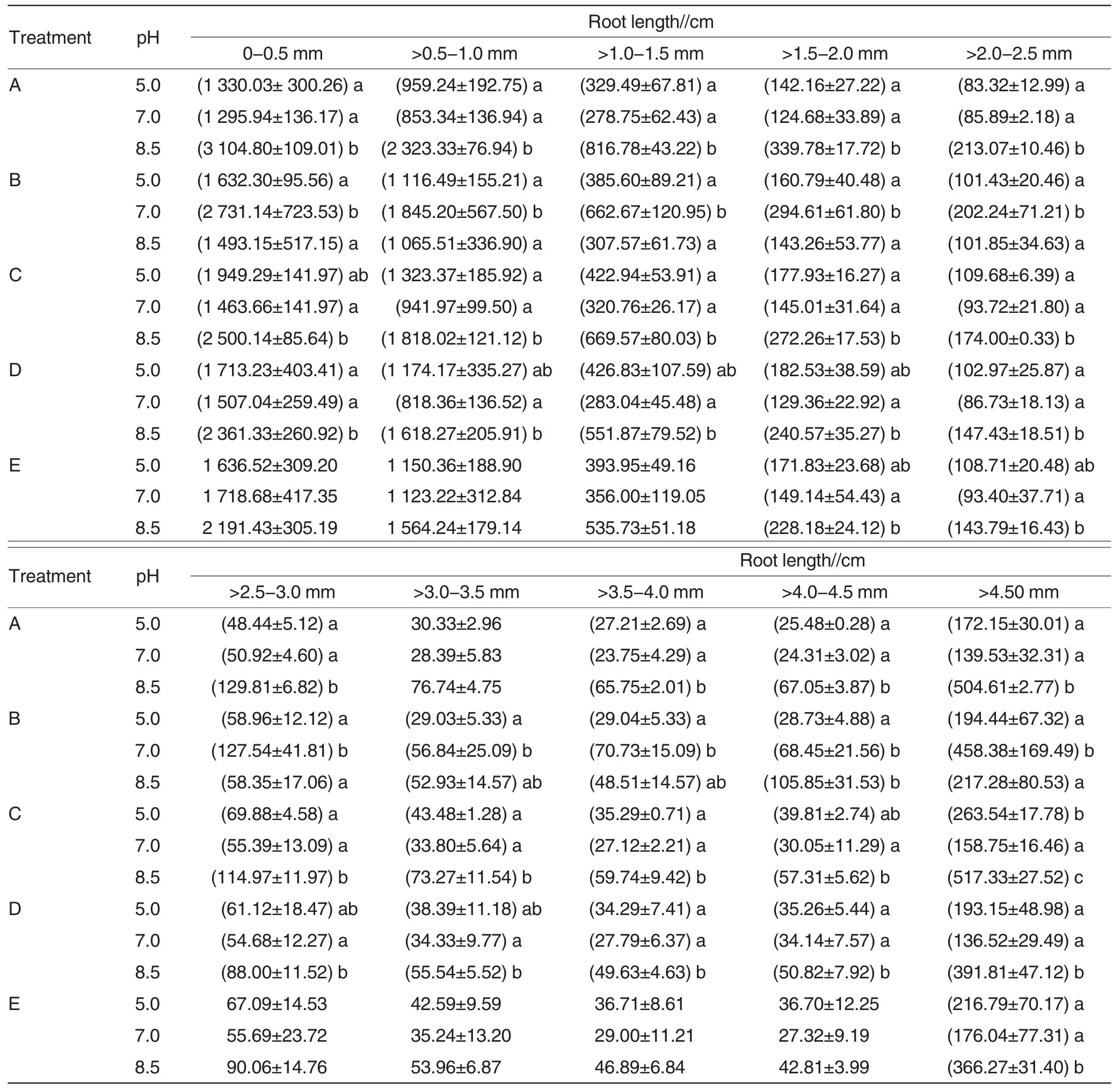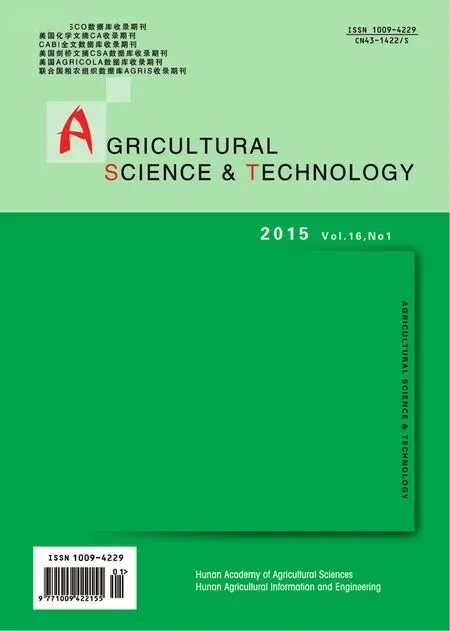Effects of Nutrient Solution pH on the Growth of Seedlings of Sugarcane
Liping ZHAO,Jiayong LIU*,Peifang ZHAO,Fenggang ZAN,Jun ZHAO,Kun YANG,Caiwen WU,Xuekuan CHEN
1.Sugarcane Research Institute,Yunnan Academy of Agricultural Sciences,Kaiyuan 661699,China;
2.Yunnan Province Key Laboratory of Sugarcane Genetic Improvement,Kaiyuan 661699,China
Responsible editor:Xiaoxue WANG Responsible proofreader:Xiaoyan WU
Soil pH plays a key role in plant growth which will be adversely affected by inappropriate pH.In China,pH of soil tends to be volatile from south to north,and pH generally keeps acid over 81%[1].Furthermore,the soils with pH below 5.5 account for 62%.For example,arithmetic mean value and geometric mean of soil pH of sugarcane-producing areas are 4.35 and 4.34[2]in Liangjiang Town,Xingbin District,Guangxi Province.Hence,it is extremely strong acid soils.Although sugarcane is tolerant to soil infertility and acidity,excessive acidity would reduce use rate of P fertilizers and affect sugarcane root growth,decreasing yield[1].Currently,the researches available are mainly on wheat,rice,tobacco and peanut,in terms of relationship between biological activity and pH value[3-10].Less attention is paid to the effects of pH on seedling root growth of sugarcane[11].The research explored the effects of nutrient solutions with different pH values on biomass,root shape,root activity,stem diameter and plant height of seedlings in order to select the sugarcane varieties and the most suitable pH environment for sugarcane growth.
Materials and Methods
Materials
The hybrid generations of RB85-5156×Yunrui 05-407,Yunrui 06-3501×Tolodo,Yuetang 94-128×Ganzhe 75-65,ROC6 ×Yunrui 05-733,VMC87-95×Yunrui 05-171 were taken as materials,recorded as A,B,C,D,and E,respectively.
Methods
The hybrid seeds were sown in June 2012 in a greenhouse,Sugarcane Research Institute,Yunnan Academy of Agricultural Sciences.Then,seedlings of the 5 treatments were sampled randomly and cultivated as per local method.When 4-5 leaves of seedlings grew,the seedling growing similarly can be transplanted to a pot where substrates were river sands washed clean.After the transplanting,the seedlings were irrigated with running water and then treated with nutrient solutions with the seedlings matured.Specifically,pH was set at 5.0,7.0 and 8.5 and every treatment was with three repetitions,namely,3 pots were involved of every pH value for each hybrid seed treatment.It is notable that every pot was with a repetition at 15 plants per pot (height at 32 cm and diameter at 35 cm).The value of pH was measured with a pH meter(pH-3C) and the value of pH was adjusted to the ruled one with 1 mol/L H2SO4and 1 mol/L NaOH.The nutrient solution was Hoagland’s solution and seedlings were irrigated weekly.After the plant grew for 130 d,biomass,plant height,stem diameter,root shape,and root activity were measured accordingly.
Measurement index and methods
According to measurements of root system,a complete plant was collected from a cultivation pot and washed clean with running water.Subsequently,the clean seedlings were removed from a plant and surface water was dried with absorbent paper.The seedlings were then separated as per simple root and placed side by side on a specific root tray.The root system was then scanned with a Win-RHIZO LA6400XL and the scanned pictures were stored in different folders as per plant number,repetition,and classification.Then,total root length,root surface area,average diameter of root system,root volume and root length with different diameters were computed with a WinRHIZO.
Stem diameter and plant height were measured as per local method.
Biomass was measured as follows:Ground seedlings and roots were cleaned with running water and water was absorbed with absorbent paper to measure the weight.Then,the seedlings were killed out at 105 ℃for 0.5 h and dried to a constant weight at 70 ℃to measure the dry weight.
Root activity was measured as per TTC method[12].Specifically,the root tip was collected at 0.5 g and added with 0.4% TTC at 0.2 ml and 1/15 PBS at 5 ml,which was stored for 1 h in dark at 37 ℃.Then,1 mol/L H2SO4was added to end the reaction.The materials were then collected to dry with filter paper,added with ethyl acetate,followed by grinding.The red extracting solution was collected and solution was fixed to a constant volume at 10 ml with ethyl acetate.The reduction quantity (C) of TTC was measured with a spectrophotometer at 485 nm.
The root activity=C/(Wt×1 000),which C refers to the reduction quantity of tetrazole (μg/(g·h)),W refers to root mass (g),and t represents the reaction time(h).
Data processing
The test data were analyzed with SPSS 18.0 and Excel 2003.
Results and Analysis
Effects of pH treatments on seedling growth during seedling period
Effects on biomasses of root system and ground part of plantsAs shown in Table1,with pH at 8.5,fresh weight and dry weight of plant and root system in treatments A and D,as well as dry weight of plant and root system in treatment B,maintained higher compared with the treatment with pH at 5.0.In treatment E,the differences of biomass showed none statistical significance with Ph designed at three levels.It can be concluded that the value of pH at 5.0 has inhibition on seedling biomass accumulation.
Effects on morphological characteristics of root systemAs shown in Table2,morphological characteristics of root system changed dramatically in the five treatments and total root length,surface root area,root diameter and root volume in treatments A,C and D all reached the lowest with pH value at 7.0,and the highest with pH value at 8.5,when total root length,surface root area,and root volume were all significantly higher compared with the treatment with pH at 5.0.With pH at 7.0,except of root diameter,the rest characteristics of root system were all higher compared with the treatments with pH values at 5.0 and 8.5.In addition,for pH value at 8.5,total root length and surface root area ofthe seedlings were both higher compared with the treatments with pH at 5.0.It can be concluded that the effects of nutrient solution with pH value are of none statistical significance.

Table1 The biomasses of seedlings from three pH levels g

Table2 Root morphological features of seedlings from three pH levels
Effects on root activityAs shown in Fig.1,root activity of seedlings in treatment A was increasing upon pH,and reached the peak with pH value at 8.5; in treatment B,root activity changed from increasing to decreasing upon pH and achieved the peak at 316.04 μg/(g·h) with pH value at 7.0;in treatment C,root activity changed from substantial decrease to slow growth upon pH value,and the activity with pH value at 5.0 was significantly higher at 1 009.31 μg/(g·h) compared with rest treatments; in treatment D and E,root activity was decreasing as pH value enhanced,and the activity performed significantly higher with pH of 5.0 compared with the treatment with pH of 8.5.Of the 5 treatments,root activity achieved the peak with pH value at 5.0 in treatments C,D and E,and in treatments C and E with pH value at 5.0,root activity proved the highest.
Effects on stem diameterAs shown in Fig.2,stem diameter changed insignificantly with varying pH values.Specifically,stem diameters in treatments A,B,C and D all changed from increasing to decreasing; the stem diameter in treatment A with pH of 7.0 was significantly higher compared with the treatments with pH of 5.0; the stem diameter in treatment E changed from decreasing to increasing.

Table3 Root length of seedling at different diameters from three pH levels
Effects on plant heightAs shown in Fig.3,plant heights in treatments A,B,C,and D all reached the highest with pH of 8.5 and plant height was significantly higher in treatment C with pH of 8.5,compared with that with pH of 5.0; in treatment B,plant height changed from decreasing to increasing and increasing to decreasing in treatment E.
Effects on root lengthIt can be concluded from Table3 that the root with diameter below or equal to 1.0 mm was longer,and the range of root length in treatments A and C with pH of 8.5 was significantly larger compared with that with pH of 5.0 and 7.0;in treatment B,root length in the treatment B with pH of 7.0 was far higher compared with that with pH of 5.0 and 8.5; in treatment E,differences of diameter with pH values in treatment E showed none statistical significance,except of the diameter over 4.5 mm.
Conclusions and Discussions
Water,salt and P stress all have considerable effects on plant and root system growth[13-17].Li et al.[18]researched root system shape and root activity and the results indicated that as pH increased,growth of different plants was inhibited in varying degrees and biomasses of root and ground part both dropped substantially; the inhibition proved higher of ground part[18].The research incorporated that the accumulated biomass was more in the treatment with pH of 8.5; the values of pH at 7.0 and 8.5 were conductive for seedling growth;the value of pH at 5.0 was adverse for seedling growth.
[1]GUO JW (郭家文),LIU SC (刘少春),ZHANG YB (张跃彬),et al.Distribution of Soil pH and Total N,P,K in Main Sugarcane Fields in Yunnan Provinc(云南甘蔗主产区土壤pH、全氮磷钾的分布状况)[J].Soils(土壤),2012(5):868-872.
[2]RAO J (饶江),GU MH (顾明华),SHEN FK (沈方科),et al.Spatial variation of pH,secondary and trace elements in red soils in sugarcane fields (红壤甘蔗地土壤pH 及中、微量元素含量空间变异研究)[J].Chinese Journal of Soil Science(土壤通报),2009(4):795-799.
[3]LI QF(李清芳),XIN TR(辛天蓉),MA CC(马成仓),et al.Effects of pH value on wheat seed germination and seedlings growth and metabolism(pH对小麦种子萌发和幼苗生长代谢的影响)[J].Journal of Anhui Agricultural Sciences(安徽农业科学),2003,31(2):185-187.
[4]QUAN SH(全松华),WANG YG(汪永国),LUO SQ (罗绍球),et al.Effects of the pH value of bed soil in seedling quality in rice (苗床土壤pH对水稻秧苗素质的影响)[J].Hybrid Rice (杂交水稻),2004,19(4):45-46.
[5]LIU SH (刘少华),XIE PF (谢鹏飞),XU GH(徐国华),et al.Effects of root pH on highly-yielding hybrid rice in terms of growth characters of root system (根际pH对高产杂交稻幼苗根系生长特性的影响[J].Jiangsu Agricultural Sciences(江苏农业科学),2013(1):70-72.
[6]CHEN JJ (陈建军),REN YH (任永浩),HAN JF (韩锦峰).Effects of pH of roots on tobacco root growth(根际pH值对烟草根系生长的影响 (简报))[J].Plant Physiology Journal (植物生理学通讯),1993,29(1):34-37.
[7]MENG QL (孟庆玲),CHENG ZH (程智慧),XU P(徐鹏),et al.Effects of nutrient solution pH value on growth and physiological characteristics of Gerbera jamesonii Bolus(营养液pH对非洲菊生长和生理特征的影响)[J].Acta Botanica Boreali-Occidentalia Sinica(西北植物学报),2010(10):2081-2086.
[8]JIANG AF(蒋爱凤),CHEN CL(陈翠玲),REN XJ (任秀娟),et al.Influence of soil pH on the root pH and growth of peanut seedlings (土壤pH对花生幼苗期根系pH 及其生长状况的影响)[J].Journal of Henan Agricultural Sciences (河南农业科学),2006(7):51-52.
[9]XU XY (徐晓燕),SUN WS (孙五三),LI ZH (李章海),et al.Synthesis of nicotine of tobacco roots and effects of pH values on the roots growth and quality of tobacco(烤烟根系合成烟碱的能力及pH对其根系和品质的影响)[J].Journal of Anhui Agricultural University (安徽农业大学学报),2004(3):315-319.
[10]ZHANG X(张旭),LIU YZ(刘彦卓).Effects of soil pH on quality of doublecropping rice in southern part of China(土壤pH对华南双季稻旱育秧素质的影响试验初报)[J].Guangdong Agricultural Sciences(广东农业科学),1998(2):8-10.
[11]LIU GL (刘光玲),CHEN RF (陈荣发),TIAN FQ (田富桥),et al.Effects of different values on growth and physiological characteristics of sugarcane seedlings (不同pH对甘蔗幼苗生长和生理特性的影响)[J].Journal of Southern Agriculture (南方农业学报),2011(4):380-383.
[12]ZOU Q(邹琦).Guidance of plant biological tests (植物生理学试验指导)[M].Beijing:China Agriculture Press(北京:中国农业出版社),2000:62-63.
[13]YI LP(弋良朋),MA J(马健),Li Y(李彦).The comparisons of root system and root hair morphological characteristics among three desert halophytes(3种荒漠盐生植物根系及根毛形态特征的比较研究)[J].植物研究,2007,27(2):204-211.
[14]HAN XY(韩希英),SONG FB(宋凤斌).Effect of drought stress on root growth and rhizosphere nutrient of maize(干旱胁迫对玉米根系生长及根际养分的影响)[J].Journal of Soil and Water Conservation(水土保持学报),2006,20(3):170-172.
[15]MIAO HX(苗海霞),SUN MG(孙明高),XIA Y(夏阳),et al.Effects of salt stress on root activity of Melia azedarach seedlings(盐胁迫对苦楝根系活力的影响)[J].Journal of Shandong Agricultural University(Natural Science)(山东农业大学学报:自然科学版),2005,36(1):9-12.
[16]LI HM (李慧明),GAO ZQ (高志强),ZHANG YQ(张永清),et al.The biological response of root system of different genotypes spring wheat to low phosphorus stress(不同基因型春小麦根系对低磷胁迫的生物学响应)[J].Journal of Shanxi Agricultural University(Natural Science?Edition)(山西农业大学学报:自然科学版),2006,26(2):138-140.
[17]HUANG H(黄沆),CHEN GH(陈光辉).Status and prospect of research on rice root breeding (水稻根系育种的研究现状及展望)[J].Journal of Hunan Agricultural University (Natural Sciences)(湖南农业大学学报:自然科学版),2009,35(1):35-39.
[18]LI CJ(李从娟),MA J(马健),LI Y(李彦),et al.Effects of pH value on the morphological features and activity of roots of three life-form plant species(pH对3种生活型植物根系形态及活力的影响)[J].Arid Zone Research (干旱区研究),2010,27(6):915-920.
 Agricultural Science & Technology2015年1期
Agricultural Science & Technology2015年1期
- Agricultural Science & Technology的其它文章
- Effects of Soaking Seeds with Different Solutions on the Growth and Yield of Rice
- The Breeding and Application of a New Super High-yield Mini Watermelon Variety‘Jinmi 2’
- Effects of Traditional Chinese Herbal Medicine on the Structure of Duodenal Mucosa of Chickens under Heat Stress
- Optimization of Microwave Extraction of Flavonoids from Water Chestnut Skin Dregs with Response Surface Method
- Establishmentand Comparison of Two TaqMan Real-time PCR Methods for PCV2
- Characteristics and High-yielding Cultivation Technology of HuaimaiNo.29
